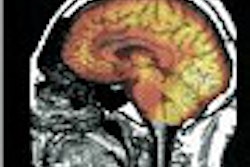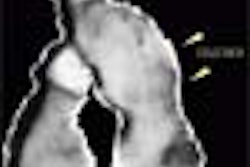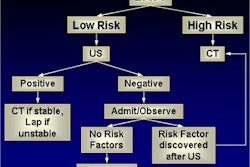(Ultrasound Review) Three sonographic stages of testicular torsion in infants and neonates were described in a recent study published in American Journal of Roentgenology. According to an international research team, these three stages of evolution have not previously been described sonographically.
This retrospective study included 30 neonates and infants from Pontificia Universidad Catolica de Chile in Santiago and The Hospital for Sick Children in Toronto. Patient age ranged from birth to two months. All patients presented with scrotal swelling and discoloration and had abnormal ultrasound findings consistent with testicular torsion. Grayscale and color and pulsed Doppler ultrasound were performed with state-of-the-art equipment with high-frequency linear array transducers.
"Treatment of the patients was not uniform because they were diagnosed and treated at two different institutions by a variety of pediatricians, surgeons, and urologists over a six-year period. Eleven patients were treated nonoperatively and 19 had surgery," they reported.
They categorized abnormal ultrasound findings into three groups that represented the progression of ischemic necrosis after torsion and infarction. Type I (N=15, acute phase) showed gross testicular enlargement with heterogeneous texture, with subtunica fluid and absent flow on Doppler.
All had a hydrocele with thickening of the surrounding soft tissues, and eight had a contralateral hydrocele. Type II (N=12, late phase) demonstrated normal testicular size and heterogeneous texture and some had a small hydrocele. Type III (N=3) showed a significant decrease in testicular size with increased echogenicity without hydrocele.
Nineteen patients were surgically treated. Seventeen had ipsilateral orchiectomy and contralateral orchidopexy, and the two group III patients only had contralateral orchidopexy. The remaining 11 infants were treated conservatively, with surgery planned at a later date. Follow-up ultrasound was performed at an average of seven months in seven patients and progression of disease was shown in all cases.
The authors concluded, "neonatal testicular torsion represents a unique clinical entity. In addition to the absence of arterial flow to the testicle, characteristic sonographic features can be shown that aid in decisions regarding treatment and follow-up."
Testicular torsion in neonates and infants: sonographic features in 30 patientsTraubici, J. et al.
Department of diagnostic imaging, the Hospital for Sick Children, University of Toronto, Toronto; Pontificia Universidad Catolica de Chile, Santiago
AJR 2003 March; 180:1143-1145
By Ultrasound Review
June 16, 2003
Copyright © 2003 AuntMinnie.com



















